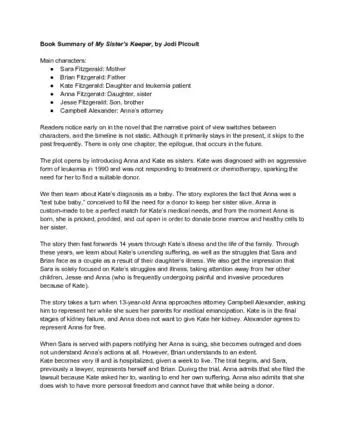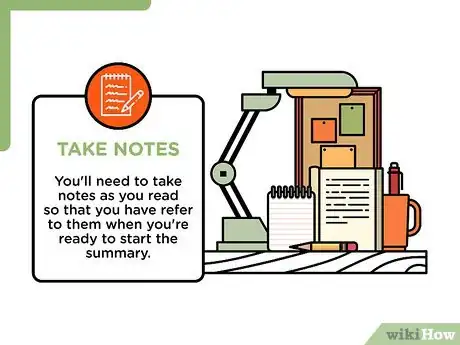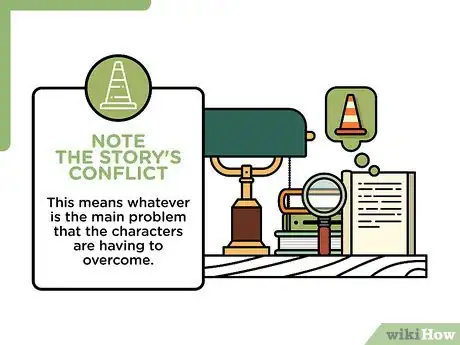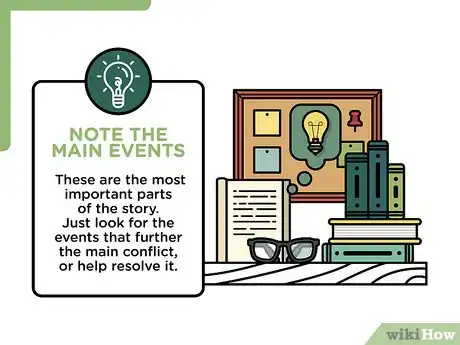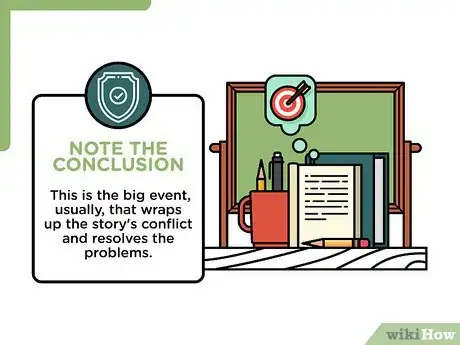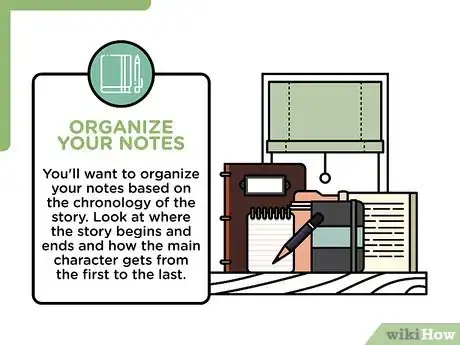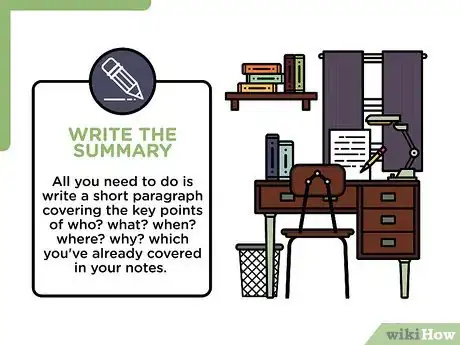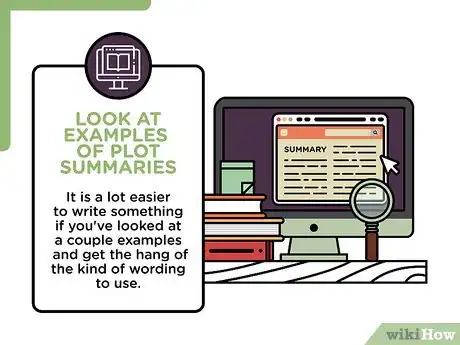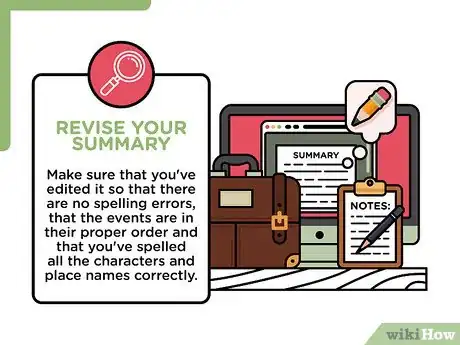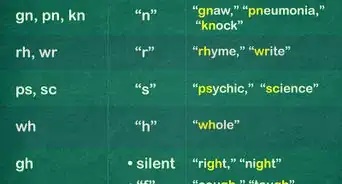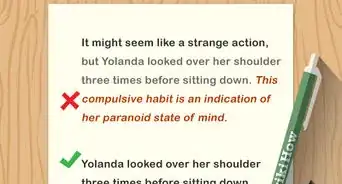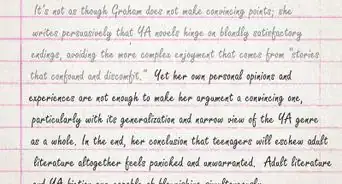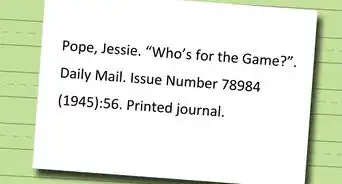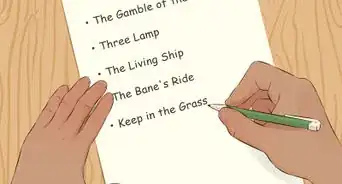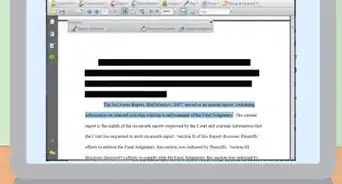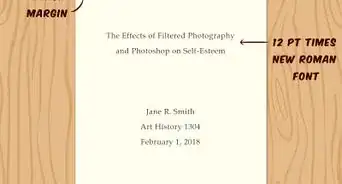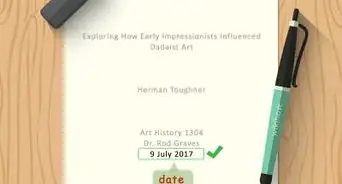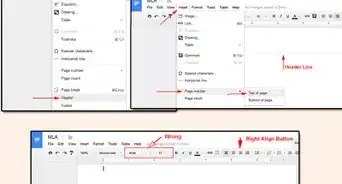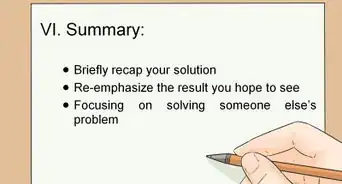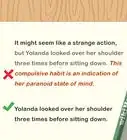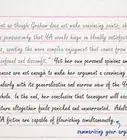This article was co-authored by Richard Perkins. Richard Perkins is a Writing Coach, Academic English Coordinator, and the Founder of PLC Learning Center. With over 24 years of education experience, he gives teachers tools to teach writing to students and works with elementary to university level students to become proficient, confident writers. Richard is a fellow at the National Writing Project. As a teacher leader and consultant at California State University Long Beach's Global Education Project, Mr. Perkins creates and presents teacher workshops that integrate the U.N.'s 17 Sustainable Development Goals in the K-12 curriculum. He holds a BA in Communications and TV from The University of Southern California and an MEd from California State University Dominguez Hills.
There are 13 references cited in this article, which can be found at the bottom of the page.
This article has been viewed 378,459 times.
When you're writing a summary of a story it needs to be short, sweet, and to the point. Fortunately, this isn't hard if you follow certain guidelines.
Steps
Sample Summaries
As You're Reading
-
1Read the story. It will be very difficult to summarize a story without actually reading it. So crack open your book, or plug in some headphones and listen to it on your iPod. Don't always trust the internet sites that claim to summarize books, because they aren't always accurate.[1]
- As you're reading, keep in mind what the central idea of the story is.[2] For Lord of the Rings, for instance, the central idea might be something about how the power of greed (i.e. the Ring) is a strong force for evil, or even the actions of one insignificant person (like a hobbit) can change the world.[3]
- Concentrate fully on the book. Don't get distracted by anything, not even music.
-
2Take notes.[4] You'll need to take notes as you read so that you have refer to them when you're ready to start the summary. Look for the "who? what? when? where? why?" These will give you the basis for what you want to cover in your summary.[5] [6]Advertisement
-
3Find the main characters. You'll need to know who the story is about, after all, and you need to figure out which characters aren't as important to the narrative.[7] If you're reading a story with tons of characters, you won't want to note down every single character that appears.
- For example: for Harry Potter and the Sorcerer's Stone you would write down Harry Potter, Ron Weasley, Hermione Granger, because they are the main characters. You might even note down Hagrid, Dumbledore, Snape, Quirrell, and Voldemort because they figure importantly in the story.
- You wouldn't need to write down Peeves the poltergeist, or Norbert the dragon, because while they are important in their places in the story, they don't influence the main storyline enough to be part of the summary.
- A shorter story like "Little Red Riding Hood" is easy because you only have to note down Red Riding Hood, her grandmother, the wolf, and the woodcutter (depending on the version).
-
4Note down the setting. The setting is where the events take place. Now this can get complicated if the story you're reading takes place in a lot of different places. If that's the case, you'll need to be more broad.[8]
- Continuing the Harry Potter example: the main action takes place at Hogwarts, so you could write down something like 'the magical school Hogwarts in the United Kingdoms.'
- Now for a story like Lord of the Rings, which takes place over a large amount of territory, you can mention that it's Middle-Earth, and note some places of important like the Shire, Mordor, and Gondor. You don't have to go too specific (like mentioning the forest Fangorn, or the tower Minas Morgul).
-
5Note the story's conflict. This means whatever is the main problem that the characters are having to overcome.[9] It doesn't necessarily have to be a villain, like with Harry Potter and Lord of the Rings.[10]
- For Harry Potter, the main conflict is Voldemort's attempt to steal the Sorcerer's Stone and return to menace the Wizard World (and kill Harry).
- For example, if you're summarizing The Odyssey, the main conflict is Odysseus trying to get home to Ithaca. Everything about the story is driven by his desire to get home and all the obstacles standing in his way.
-
6Note the main events. These are the most important parts of the story. You don't need to note down every single thing that a character does. In fact, that is exactly what you're supposed to not do! Just look for the events that further the main conflict, or help resolve it.[11]
- For Harry Potter, some main events would be Harry finding out he's a wizard, or Harry meeting the three-headed dog and, of course, Harry, Ron, and Hermione defeating Voldemort.
- It might seem easier for a shorter story like 'Little Red Riding Hood,' but you should only note down the most important moments like Riding Hood meeting the wolf, getting eaten after she mistakes the wolf for her grandmother, and the appearance of the woodcutter.
-
7Note the conclusion. This is the big event, usually, that wraps up the story's conflict and resolves the problems. Even in a book that is part of a series there is usually some sort of conclusion to the story.[12] Spoilers below!
- For Harry Potter the conclusion is defeating Voldemort. The story after that isn't important to the summary, even if it is important to the overall story. You won't need to go into the conversation between Dumbledore and Harry at the end, or even the Gryffindor House winning points, because it isn't really part of the main Voldemort storyline.
- For Red Riding Hood, the conclusion is the appearance of the woodcutter to save her and her grandmother.
- For something like Lord of the Rings, the conclusion is complicated for a summary, because you may want to stop off at the destruction of the Ring, but (especially if the central idea of the story is the importance of the the deeds of one insignificant person) you will want to mention the Scouring of the Shire, and Frodo's departure from the Grey Havens.
Writing Your Summary
-
1Organize your notes. The hardest part is already finished, reading the book! if you've taken all your notes, you're completely ready to write the summary. You'll want to organize your notes based on the chronology of the story. Look at where the story begins and ends and how the main character gets from the first to the last.[13]
- To continue with the Harry Potter example, you'll need to look at how Harry went from learning he was a wizard to defeating Voldemort.
- For something like The Odyssey you'll need to look at how Odysseus gets from his losing all his men and washing up on Calypso's island to defeating the suitors and convincing Penelope of his identity.
- A short story like Red Riding Hood, you'll need to look at why Riding Hood was going into the woods, how she was fooled into being eaten and how she was saved.
-
2Write the summary. This will be totally easy, now that you've gotten all your notes in order. All you need to do is write a short paragraph covering the key points of who? what? when? where? why? which you've already covered in your notes. Make sure that you also include the title of the story and the name of the author.[14]
- Make sure that you only focus on the main plot of the story. Don't get side tracked into Harry's Quidditch playing, or his feud with Malfoy.
- Likewise, don't quote from the story itself. You don't need to replicate conversations from the story in the summary. You might need to briefly mention the key point from a conversation (like 'When Harry and his friends discover from Hagrid that the Sorcerer's Stone might no longer be safe, they go to stop the thief themselves.')
-
3Look at examples of plot summaries. It is a lot easier to write something if you've looked at a couple examples and get the hang of the kind of wording to use and the way to incorporate all the different elements into one short, cohesive piece.
- 'J.K. Rowling's "Harry Potter and the Sorcerer's Stone" tells the story of eleven-year-old orphan Harry Potter, who discovers that he is a wizard and goes to study magic at the British school for wizards, Hogwarts. While there he discovers that his parents were killed by the evil wizard, Voldemort, who was destroyed by Harry when he was a baby. With his friends, Ron Weasley, who comes from a large family of wizards, and Hermione Granger, the smartest witch in their year, Harry figures out that the Sorcerer's Stone, which gives eternal life, is hidden on the off-limits third floor. When Harry and his friends discover from Hagrid that the Sorcerer's Stone is no longer be safe, they go to stop the thief themselves, who they think is Professor Snape, who hates Harry. When Harry finds the Stone, he discovers that the thief is Professor Quirrell, who is possessed by Voldemort. Because of a spell cast by Harry's mother, he is able to defeat Quirrell and Voldemort is forced back into hiding.'
- 'Homer's epic poem "The Odyssey" tells the story of the Greek hero, Odysseus, and ten-year voyage to get home to the island of Ithaca where his wife, Penelope, and his son, Telemachus waited. It begins with Odysseus imprisoned by the nymph Calypso until the Greek Gods force her to free him. The god Poseidon, who harbors a grudge against Odysseus for blinding his son the Cyclops Polyphemus previously in his travels, attempts to wreck his ship, but is stopped by the goddess Athena. Odysseus makes it to Scheria, home of the Phaeacians, where he is given safe passage and asked about his journeys to this point. Odysseus tells them of the variety of adventures he suffered through with his crew, the trip to the Land of the Lotus Eaters, his blinding of Polyphemus, his love affair with the witch-goddess Circe, the deadly Sirens, the journey into Hades, and his fight with the sea monster Scylla among them. The Phaeacians take him safely to Ithaca, where he enters the hall disguised as a beggar. In Ithaca, supposing Odysseus to be dead, suitors have taken over his hall, tried to kill his son and tried to convince Penelope to choose one of them. Penelope, believing Odysseus to be alive, has refused. She arranges a contest with Odysseus's bow, that only he can string. Once he's strung it, he shoots all the suitors and is reunited with his family.'
- These summaries cover the main plots of the stories that they're summarizing. They use sentences like "When Harry finds the Stone..." instead of explaining exactly what it took to find the stone, which is not the point of a summary. They are brief and they focus only on the most important main characters, like Odysseus, Penelope, the gods, etc.
-
4Revise your summary. Make sure that you've edited it so that there are no spelling errors, that the events are in their proper order and that you've spelled all the characters and place names correctly. It's best to have a friend look it over to catch anything you've missed. Once you've revised it, the summary is ready to go![15]
Community Q&A
-
QuestionWhich notes should I take?
 Community AnswerTo summarize a story, find the main points of the story. Asses whether the detail you have included in the summary affects the story.
Community AnswerTo summarize a story, find the main points of the story. Asses whether the detail you have included in the summary affects the story. -
QuestionCould I skip a step or two? Would it make a difference in the summary?
 Community AnswerIt shouldn't. But if the steps were related to the main conflict in the story, you should include them within the summary of the short story.
Community AnswerIt shouldn't. But if the steps were related to the main conflict in the story, you should include them within the summary of the short story. -
QuestionHow do I write a summary of a biography?
 Community AnswerSummarize like you would any other story, but instead of a fictional story you will be summarizing real life event. Highlight the main things that happened during his life and the main people in his.
Community AnswerSummarize like you would any other story, but instead of a fictional story you will be summarizing real life event. Highlight the main things that happened during his life and the main people in his.
Warnings
- If you're writing an essay, you shouldn't only summarize the text.⧼thumbs_response⧽
- Don't include your opinions when writing a summary unless you are explicitly prompted to by your teacher.⧼thumbs_response⧽
References
- ↑ https://penandthepad.com/correctly-summarize-short-story-5031.html
- ↑ Richard Perkins. Writing Coach & Academic English Coordinator. Expert Interview. 1 September 2021.
- ↑ https://writingcenter.unc.edu/tips-and-tools/summary-using-it-wisely/
- ↑ https://learningcenter.unc.edu/tips-and-tools/taking-notes-while-reading/
- ↑ Richard Perkins. Writing Coach & Academic English Coordinator. Expert Interview. 1 September 2021.
- ↑ https://fs.blog/2013/11/taking-notes-while-reading/
- ↑ Richard Perkins. Writing Coach & Academic English Coordinator. Expert Interview. 1 September 2021.
- ↑ https://penandthepad.com/parts-story-introduction-body-conclusion-6472733.html
- ↑ https://penandthepad.com/major-conflict-story-8483658.html
- ↑ Richard Perkins. Writing Coach & Academic English Coordinator. Expert Interview. 1 September 2021.
- ↑ Richard Perkins. Writing Coach & Academic English Coordinator. Expert Interview. 1 September 2021.
- ↑ https://penandthepad.com/parts-story-introduction-body-conclusion-6472733.html
- ↑ https://writershelpingwriters.net/2017/04/the-efficient-writer-using-timelines-to-organize-story-details/
- ↑ https://www.kellogg.edu/upload/eng151/chapter/how-to-write-a-summary/index.html
- ↑ https://www.eecis.udel.edu/~carberry/Papers/Mani-revision-99.pdf
- ↑ https://study.com/learn/lesson/what-is-a-summary.html
- https://public.wsu.edu/~mejia/Summary.htm
- https://www.lbcc.edu/sites/main/files/file-attachments/summarizingparagraph.pdf
About This Article
To summarize a story as you read, take notes about the characters, plot, and setting. When you’ve finished the story, organize your notes chronologically so you can see how the story develops from beginning to end. Then, write a paragraph describing the characters, followed by one dealing with the basic plot points. Next, note the time period, the setting, and the main takeaways from the story. When you’ve touched on all these elements, go back and revise your summary so there are no errors. For sample summaries and ways to use them when you’re writing your own, keep reading.

